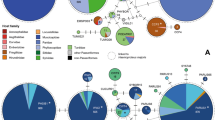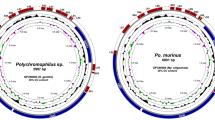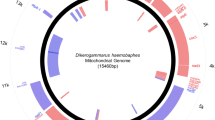Abstract
Members of the order Haemosporida are protist parasites that infect mammals, reptiles and birds. This group includes the causal agents of malaria, Plasmodium parasites, the genera Leucocytozoon and Fallisia, as well as the species rich genus Haemoproteus with its two subgenera Haemoproteus and Parahaemoproteus. Some species of Haemoproteus cause severe disease in avian hosts, and these parasites display high levels of diversity worldwide. This diversity emphasizes the need for accurate evolutionary information. Most molecular studies of wildlife haemosporidians use a bar coding approach by sequencing a fragment of the mitochondrial cytochrome b gene. This method is efficient at differentiating parasite lineages but insufficient for accurate phylogenetic inferences in highly diverse taxa such as haemosporidians. Recent studies have utilized multiple mitochondrial genes (cyt b, cox1 and cox3), sometimes combined with a few apicoplast and nuclear genes. These studies have been highly successful with one notable exception: the evolutionary relationships of the genus Haemoproteus remain unresolved. Here we describe the transcriptome of Haemoproteus columbae and investigate its phylogenetic position recovered from a multi-gene dataset (600 genes). This genomic approach restricts the taxon sampling to 18 species of apicomplexan parasites. We employed Bayesian inference and maximum likelihood methods of phylogenetic analyses and found H. columbae and a representative from the subgenus Parahaemoproteus to be sister taxa. This result strengthens the hypothesis of genus Haemoproteus being monophyletic; however, resolving this question will require sequences of orthologs from, in particular, representatives of Leucocytozoon species.


Similar content being viewed by others
References
Adriano EA, Cordeiro NS (2001) Prevalence and intensity of Haemoproteus columbae in three species of wild doves from Brazil. Mem Inst Oswaldo Cruz 96(2):175–178
Altschul SF, Gish W, Miller W, Myers EW, Lipman DJ (1990) Basic local alignment search tool. J Mol Biol 215(3):403–410
Auburn S, Campino S, Clark TG, Djimde AA, Zongo I, Manske M, Mangano V, Alcock D, Anastasi E, Maslen G, MacInnis B, Rockett K, Modiano D, Newbold CI, Doumbo OK, Ouédrago JB, Kwiatkowski DP (2011) An effective method to purify Plasmodium falciparum DNA directly from clinical blood samples for whole genome high-throughput sequencing. PLoS ONE 6(7):4–11
Aurrecoechea C, Brestelli J, Brunk BP, Dommer J, Fischer S, Gajria B, Gao X, Gingle A, Grant G, Harb OS, Heiges M, Innamorato F, Iodice J, Kissinger JC, Kraemer E, Li W, Miller JA, Nayak V, Pennington C, Pinney DF, Roos DS, Ross C, Stoekert CJ Jr, Treatman C, Wang H (2008) PlasmoDB: a functional genomic database for malaria parasites. Nucleic Acids Res 37(Suppl_1):D539–D543
Babraham Bioinformatics (2017) http://www.bioinformatics.babraham.ac.uk/
Bensch S, Hellgren O, Pérez-Tris J (2009) MalAvi: a public database of malaria parasites and related haemosporidians in avian hosts based on mitochondrial cytochrome b lineages. Mol Ecol Resour 9(5):1353–1358
Bensch S, Canbäck B, DeBarry JD, Johansson T, Hellgren O, Kissinger JC, Palinauskas V, Videvall E, Valkiūnas G (2016) The Genome of Haemoproteus tartakovskyi and its relationship to human malaria parasites. Genome Biol Evol 8(5):1361–1373
Böehme U, Otto TD, Cotton J, Steinbiss S, Sanders M, Oyola SO, Nicot A, Gandon S, Patra KP, Herd C, Bushell E, Modrzynska KK, Billker O, Vinetz JM, Rivero A, Newbold CI, Berriman M (2018) Complete avian malaria parasite genomes reveal host-specific parasite evolution in birds and mammals. Genome Res 28:547–560
Borner J, Pick C, Thiede J, Kolawole OM, Kingsley MT, Schulze J, Cottontail VM, Wellinghausen N, Schmidt-Chanasit J, Burmester T (2016) Phylogeny of haemosporidian blood parasites revealed by a multi-gene approach. Mol Phylogenet Evol 94:221–231
Bozdech Z, Llinás M, Pulliam BL, Wong ED, Zhu J, DeRisi JL (2003) The transcriptome of the intraerythrocytic developmental cycle of Plasmodium falciparum. PLoS Biol 1(1):e5
Carlson JS, Martínez-Gómez JE, Valkiūnas G, Loiseau C, Bell DA, Sehgal RN (2013) Diversity and phylogenetic relationships of hemosporidian parasites in birds of Socorro Island, México, and their role in the re-introduction of the Socorro Dove (Zenaida graysoni). J Parasitol 99(2):270–276
Castresana J (2000) Selection of conserved blocks from multiple alignments for their use in phylogenetic analysis. Mol Biol Evol 17(4):540–552
Dimitrov D, Palinauskas V, Iezhova TA, Bernotienė R, Ilgūnas M, Bukauskaitė D, Zehtindjiev P, Ilieva M, Shapoval AP, Bolshakov CV, Markovets MY, Bensch B, Valkiūnas G (2015) Plasmodium spp.: an experimental study on vertebrate host susceptibility to avian malaria. Exp Parasitol 148:1–16
Earlé RA, Bastianello SS, Bennett GF, Krecek RC (1993) Histopathology and morphology of the tissue stages of Haemoproteus columbae causing mortality in Columbiformes. Avian Pathol 22(1):67–80
Gajria B, Bahl A, Brestelli J, Dommer J, Fischer S, Gao X, Heiges M, Iodice J, Kissinger JC, Mackey AJ, Pinney DF, Roos DS, Stoeckert CJ, Jr, Wang H, Brunk BP (2007) ToxoDB: an integrated Toxoplasma gondii database resource. Nucl Acids Res 36(suppl_1):D553–D556
Gardner MJ, Hall N, Fung E, White O, Berriman M, Hyman RW, Carlton JM, Pain A, Nelson KE, Bowman S, Paulsen IT, James K, Eisen JA, Rutherford K, Salzberg SL, Craig A, Kyes S, Chan M, Nene V, Shallom SJ, Suh B, Peterson J, Angiuoli S, Pertea M, Allen J, Selengut J, Haft D, Mather MW, Vaidya AB, Martin DMA, Fairlamb AH, Fraunholz MJ, Roos DS, Ralph SA, McFadden GI, Cummings LM, Subramanian GM, Mungall C, Venter JC, Carucci DJ, Hoffman SL, Newbold C, Davis RW, Fraser CM, Barrell B (2002) Genome sequence of the human malaria parasite Plasmodium falciparum. Nature 419:498
Garnham PCC (1966) Malaria parasites and other haemosporidia. In: Malaria parasites and other haemosporidia. Wiley, Hoboken
Grech K, Watt K, Read AF (2006) Host–parasite interactions for virulence and resistance in a malaria model system. J Evol Biol 19(5):1620–1630
Haas BJ, Papanicolaou A, Yassour M, Grabherr M, Blood PD, Bowden J, Couger MB, Eccles D, Li B, Lieber M, MacManes MD, Ott M, Orvis J, Pochet N, Strozzi F, Weeks N, Westerman R, William T, Dewey CN, Henschel R, LeDuc RD, Friedman N, Regev A (2013) De novo transcript sequence reconstruction from RNA-Seq: reference generation and analysis with Trinity. Nat Protoc 8(8):1494
Hellgren O, Waldenström J, Bensch S (2004) A new PCR assay for simultaneous studies of Leucocytozoon, Plasmodium, and Haemoproteus from avian blood. J Parasitol 90(4):797–802
Hellgren O, Križanauskiene A, Valkiūnas G, Bensch S (2007) Diversity and phylogeny of mitochondrial cytochrome B lineages from six morphospecies of avian Haemoproteus (Haemosporida: Haemoproteidae). J Parasitol 93(4):889–896
Hellgren O, Kutzer M, Bensch S, Valkiūnas G, Palinauskas V (2013) Identification and characterization of the merozoite surface protein 1 (msp1) gene in a host-generalist avian malaria parasite, Plasmodium relictum (lineages SGS1 and GRW4) with the use of blood transcriptome. Malaria J 12(1):381
Jasper MA, Hull JM, Hull AC, Sehgal RNM (2014) Widespread lineage diversity of Leucocytozoon blood parasites in distinct populations of western Red-tailed Hawks. J Ornithol 155(3):767–775
Joint Genome Institute (2017) http://jgi.doe.gov/data-and-tools/bbtools/bb-tools-user-guide/bbduk-guide/
Keane TM, Creevey CJ, Pentony MM, Naughton TJ, Mclnerney JO (2006) Assessment of methods for amino acid matrix selection and their use on empirical data shows that ad hoc assumptions for choice of matrix are not justified. BMC Evol Biol 6(1):29
Kim D, Langmead B, Salzberg SL (2015) HISAT: a fast spliced aligner with low memory requirements. Nat Methods 12(4):357–360
Lauron EJ, Oakgrove KS, Tell LA, Biskar K, Roy SW, Sehgal RN (2014) Transcriptome sequencing and analysis of Plasmodium gallinaceum reveals polymorphisms and selection on the apical membrane antigen-1. Malaria Journal 13(1):382
Lauron EJ, Loiseau C, Bowie RC, Spicer GS, Smith TB, Melo M, Sehgal RN (2015) Coevolutionary patterns and diversification of avian malaria parasites in African sunbirds (Family Nectariniidae). Parasitology 142(5):635–647
Lee SA, Chan CH, Tsai CH, Lai JM, Wang FS, Kao CY, Huang CYF (2008) Ortholog-based protein-protein interaction prediction and its application to inter-species interactions. BMC Bioinform 9(12):S11
Lefèvre T, Sanchez M, Ponton F, Hughes D, Thomas F (2007) Virulence and resistance in malaria: who drives the outcome of the infection? Trends Parasitol 23(7):299–302
Levin II, Valkiūnas G, Santiago-Alarcón D, Cruz LL, Iezhova TA, O’Brien SL, Hailer F, Dearborn D, Schreiber EA, Fleischer RC, Ricklefs RE, Parker PG (2012) Hippoboscid-transmitted Haemoproteus parasites (Haemosporida) infect Galapagos Pelecaniform birds: evidence from molecular and morphological studies, with a description of Haemoproteus iwa. Int J Parasitol 41(10):1019–1027
Li W, Godzik A (2006) Cd-hit: a fast program for clustering and comparing large sets of protein or nucleotide sequences. Bioinformatics 22(13):1658–1659
Liu W, Li Y, Learn GH, Rudicell RS, Robertson JD, Keele BF, Ndjango JN, Sanz CM, Morgan DB, Locatelli S, Gonder MK, Kranzusch PJ, Walsh PD, Delaporte E, Mpoudi-Ngole E, Georgiev AV, Muller MN, Shaw GM, Peeters M, Sharp PM, Rayner JC, Hahn BH (2010) Origin of the human malaria parasite Plasmodium falciparum in gorillas. Nature 467(7314):420
Lutz HL, Patterson BD, Peterhans JCK, Stanley WT, Webala PW, Gnoske TP, Hackett SJ, Stanhope MJ (2016) Diverse sampling of East African haemosporidians reveals chiropteran origin of malaria parasites in primates and rodents. Mol Phylogenet Evol 99:7–15
Martinez C, Marzec T, Smith CD, Tell LA, Sehgal RN (2013) Identification and expression of maebl, an erythrocyte-binding gene, in Plasmodium gallinaceum. Parasitol Res 112(3):945–954
Martinez-de la Puente, J, Martinez J, Aguilar RD, Herrero J, Merino S (2011) On the specificity of avian blood parasites: revealing specific and generalist relationships between haemosporidians and biting midges. Mol Ecol 20(15):3275–3287
Martinsen ES, Perkins SL, Schall JJ (2008) A three-genome phylogeny of malaria parasites (Plasmodium and closely related genera): evolution of life-history traits and host switches. Mol Phylogenet Evol 47(1):261–273
Mbengue A, Bhattacharjee S, Pandharkar T, Liu H, Estiu G, Stahelin RV, Rizk S, Njimoh DL, Ryan Y, Kesinee C, Nguon C, Ghorbal M, Lopez-Rubio J, Pfrender M, Emrich S, Mohandas N, Dondorp AM, Wiest O, Haldar K (2015) A molecular mechanism of artemisinin resistance in Plasmodium falciparum malaria. Nature 520(7549):683
National Center for Biotechnology Information (NCBI)[Internet] (2017) Bethesda (MD): National Library of Medicine (US), National Center for Biotechnology Information; Accessed Apr 12 2017
Neher RA, Bedford T, Daniels RS, Russell CA, Shraiman BI (2016) Prediction, dynamics, and visualization of antigenic phenotypes of seasonal influenza viruses. Proc Natl Acad Sci USA 113(12):E1701–E1709
Notredame C, Higgins DG, Heringa J (2000) T-Coffee: a novel method for fast and accurate multiple sequence alignment. J Mol Biol 302(1):205–217
Otto TD, Wilinski D, Assefa S, Keane TM, Sarry LR, Böhme U, Lemieux J, Barrell B, Pain A, Berriman M, Newbold C, Llinas M (2010) New insights into the blood-stage transcriptome of Plasmodium falciparum using RNA-SEq. Mol Microbiol 76(1):12–24
Outlaw DC, Ricklefs RE (2014) Species limits in avian malaria parasites (Haemosporida): how to move forward in the molecular era. Parasitology 141(10):1223–1232
Oyola SO, Gu Y, Manske M, Otto TD, Alcock D, Macinnis B, Berriman M, Newbold CI, Kwiatkowski DP, Swerdlow HP, Quail MA (2012) Efficient depletion of Host DNA contamination in malaria clinical sequencing. J Clin Microbiol 51(3):745–751
Pacheco MA, Matta NE, Valkiunas G, Parker PG, Mello B, Stanley CE Jr, Lenino M, Garcia-Amado MA, Cranfield M, Pond SLK, Escalante AA (2017) Mode and rate of evolution of haemosporidian mitochondrial genomes: timing the radiation of avian parasites. Mol Biol Evol 35(2):383–403
Pacheco MA, Cepeda AS, Bernotienė R, Lotta IA, Matta NE, Valkiūnas G, Escalante AA (2018) Primers targeting mitochondrial genes of avian haemosporidians: PCR detection and differential DNA amplification of parasites belonging to different genera. Int J Parasitol 48(8):657–670
Palinauskas V, Valkiūnas G, Bolshakov CV, Bensch S (2008) Plasmodium relictum (lineage P-SGS1): effects on experimentally infected passerine birds. Exp Parasitol 120(4):372–380
Palinauskas V, Iezhova TA, Križanauskienė A, Markovets MY, Bensch S, Valkiūnas G (2013) Molecular characterization and distribution of Haemoproteus minutus (Haemosporida, Haemoproteidae): a pathogenic avian parasite. Parasitol Int 62(4):358–363
Palinauskas V, Žiegytė R, Ilgūnas M, Iezhova TA, Bernotienė R, Bolshakov C, Valkiūnas G (2015) Description of the first cryptic avian malaria parasite, Plasmodium homocircumflexum n. sp., with experimental data on its virulence and development in avian hosts and mosquitoes. Int J Parasitol 45(1):51–62
Parker IM, Saunders M, Bontrager M, Weitz AP, Hendricks R, Magarey R, Suiter K, Gilbert GS (2015) Phylogenetic structure and host abundance drive disease pressure in communities. Nature 520(7548):542–544
Perkins SL (2008) Molecular systematics of the three mitochondrial protein-coding genes of malaria parasites: corroborative and new evidence for the origins of human malaria: full-length research article. DNA Seq 19(6):471–478
Perkins SL (2014) Malaria’s many mates: past, present, and future of the systematics of the order Haemosporida. J Parasitol 100(1):11–25
PiroplasmaDB (2014), http://piroplasmadb.org
Puiu D, Enomoto S, Buck GA, Abrahamsen MS, Kissinger JC (2004) CryptoDB: the Cryptosporidium genome resource. Nucleic Acids Res 32:D329–D331
Rao VS, Srinivas K, Sujini GN, Kumar GN (2014) Protein-protein interaction detection: methods and analysis. Int J Proteomics 2014:147648
Ricklefs RE, Fallon SM (2002) Diversification and host switching in avian malaria parasites. Proc R Soc Lond B 269(1494):885–892
Ronquist F, Huelsenbeck JP (2003) MrBayes 3: bayesian phylogenetic inference under mixed models. Bioinformatics 19(12):1572–1574
Santiago-Alarcón D, Outlaw DC, Ricklefs RE, Parker PG (2010) Phylogenetic relationships of haemosporidian parasites in New World Columbiformes, with emphasis on the endemic Galapagos dove. Int J Parasitol 40(4):463–470
Stamatakis A (2014) RAxML version 8: a tool for phylogenetic analysis and post-analysis of large phylogenies. Bioinformatics 30(9):1312–1313
Sukumaran J, Holder MT (2010) DendroPy: a Python library for phylogenetic computing. Bioinformatics 26(12):1569–1571
Valkiūnas G (2005) Avian malaria parasites and other haemosporidia. CRC Press, Boca Raton
Valkiūnas G, Iezhova TA (2017) Exo-erythrocytic development of avian malaria and related haemosporidian parasites. Malaria J 16(1):101
Valkiūnas G, Iezhova TA, Loiseau C, Chasar A, Smith TB, Sehgal RN (2008a) New species of haemosporidian parasites (Haemosporida) from African rainforest birds, with remarks on their classification. Parasitol Res 103(5):1213
Valkiūnas G, Zehtindjiev P, Dimitrov D, Križanauskienė A, Iezhova TA, Bensch S (2008b) Polymerase chain reaction-based identification of Plasmodium (Huffia) elongatum, with remarks on species identity of haemosporidian lineages deposited in GenBank. Parasitol Res 102(6):1185–1193
Valkiūnas G, Santiago-Alarcón D, Levin II, Iezhova TA, Parker PG (2010) A new Haemoproteus species (Haemosporida: Haemoproteidae) from the endemic Galapagos dove Zenaida galapagoensis, with remarks on the parasite distribution, vectors, and molecular diagnostics. J Parasitol 96(4):783–792
Valkiūnas G, Ilgūnas M, Bukauskaitė D, Žiegytė R, Bernotienė R, Jusys V, Eigirdas V, Fragner K, Weissenböck H, Iezhova TA (2016) Plasmodium delichoni n. sp.: description, molecular characterisation and remarks on the exoerythrocytic merogony, persistence, vectors and transmission. Parasitol Res 115(7):2625–2636
Videvall E (2018) Plasmodium parasites of birds have the most AT-rich genes of eukaryotes. Microb Genomics 4:1–9
Videvall E, Cornwallis CK, Palinauskas V, Valkiūnas G, Hellgren O (2015) The avian transcriptome response to malaria infection. Mol Biol Evol 32(5):1255–1267
Videvall E, Cornwallis CK, Ahrén D, Palinauskas V, Valkiūnas G, Hellgren O (2017) The transcriptome of the avian malaria parasite Plasmodium ashfordi displays host-specific gene expression. Mol Ecol 26(11):2939–2958
Waite JL, Henry AR, Adler FR, Clayton DH (2012) Sex-specific effects of an avian malaria parasite on an insect vector: support for the resource limitation hypothesis. Ecology 93(11):2448–2455
Waite JL, Henry AR, Owen JP, Clayton DH (2014) An experimental test of the effects of behavioral and immunological defenses against vectors: do they interact to protect birds from blood parasites? Parasites Vectors 7(1):104
Waldenström J, Bensch S, Kiboi S, Hasselquist D, Ottosson U (2002) Cross-species infection of blood parasites between resident and migratory songbirds in Africa. Mol Ecol 11(8):1545–1554
Acknowledgements
This work was supported by Research Council of Lithuania (Grant MIP-045/2015). This study was also supported by the grant to RNMS, NIH 1SC3GM118210-01A1. The authors would like to thank Elvin J. Lauron, Bradley Bowser and Dr. Frank Cipriano for helping in planning rna-seq and project logistics. We are grateful to Dr. Greg Spicer, Andrew Ontano, Dr. Emily Jane McTavish and Trent Liu for assistance on phylogenetic and scripting advisement.
Author information
Authors and Affiliations
Corresponding author
Additional information
Accession numbers: H. columbae raw reads GenBank ID: SAMN06899305. H. columbae transcriptome assembly GenBank ID: GGWD00000000.
Electronic supplementary material
Below is the link to the electronic supplementary material.
Rights and permissions
About this article
Cite this article
Toscani Field, J., Weinberg, J., Bensch, S. et al. Delineation of the Genera Haemoproteus and Plasmodium Using RNA-Seq and Multi-gene Phylogenetics. J Mol Evol 86, 646–654 (2018). https://doi.org/10.1007/s00239-018-9875-3
Received:
Accepted:
Published:
Issue Date:
DOI: https://doi.org/10.1007/s00239-018-9875-3




